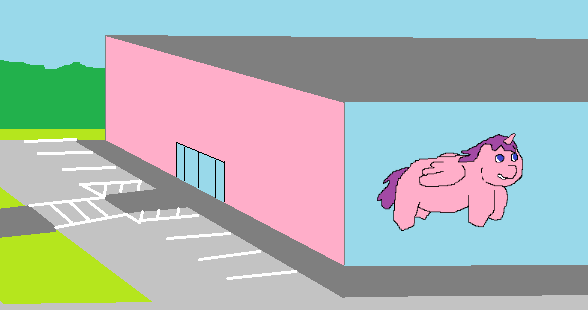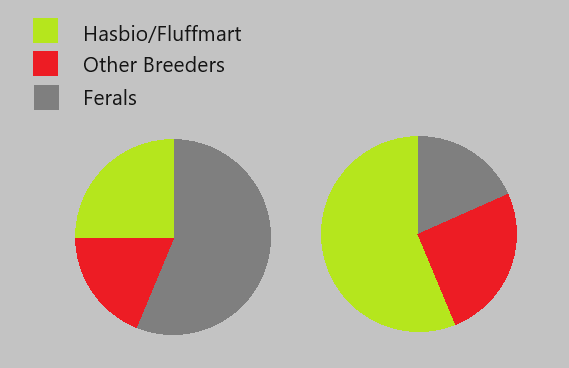The following is a transcript from a business magazine, it collects dust as it sits on a table in some veterinary lobby. Additional tables and citations omitted.

Above is a photo of the new Alicorn Supercenter nearing completion.
With nearly 80 million household fluffies in the US and an average life expectancy of six years, approximately 36 thousand are born every day. Around 1 in 4 fluffies in the US is acquired from a licensed Fluffmart. 134 thousand fluffies are delivered once biweekly among every Fluffmart location averaging around 50 foals per delivery to each of the nearly 2700 fluffmarts throughout the country.
Thanks to improvements in dietary hormones and breeding practices, Hasbio can average 7 foals per litter without miscarriage in their regional breeding facilities. Much higher than an unauthorized breeder. Foals are generally shipped off in litters of 6 with the excess foals being culled immediately for defects, recycled to maintain breeding stock, or in the case of bad colors sold for medical research.
25 regional breeding centers produce around 3200 fluffies a week each of which 2700 will be shipped between alternating weeks to different stores. Around 90 mares give birth a day with 2 weeks between each pregnancy at each location meaning each breeding center has around 2900 mares. Each mare is given a 4x4 pen, with additional space accounted for, each center is around 100,000 square foot.
Because about 5% of shipped stock, or 1 million is unsellable, it requires the distribution and disposal of an additional 38 thousand fluffies biweekly. Each store averaging 2.374 Biweekly. These are handled in euthanasia centers in accordance with the SRA.
In major areas like the East and West Coasts, the fluffmarts are close enough for local centers which humanely euthanizes defective stock from anywhere between 50 and 100 stores. For small locations in the midwest, stock is either mailed to a regional bio-disposal center or euthanasia is contracted out to veterinarians when shipping costs are excessive.
At an average retail price of $249.95, that generates a gross revenue of 875 million dollars for Fluffmart which is mostly eaten up by rent, wages, logistics, legal compliance, and the fluffies themselves in the form of kibble. Hasbio and its subsidiary Fluffmart operate on a narrow profit margin and take great efforts to minimize expenses. Fluffy food, toys, and other goods generate additional revenue for the company.
Limiting excess production of officially licensed fluffies both keeps them in the green by not needing to cull excess stock but in fact also generates some artificial scarcity throughout the year around important holidays and dates including Christmas and School Graduations which increases the image of prestige and exclusivity the company has tried in past years to recover.
Fluffmart does manage their stock to have an excess of breeders around this time to prevent losing sales to backyard breeders but many consumers prefer the inferior product for a lower price tag when holiday spending crunches the budget.
The average Fluffmart employs around 10 full or part time employees. Each breeding center employs around 250 employees between caretakers, foal sorting and packaging, admin, and drivers. Corporate employs another 600 employees who manage various things like advertising, research and development, and procurement.
With seasonal employees included, Hasbio and its subsidiary Fluffmart employs over 35000 people every year. Additional subsidiaries including FluffTV are not included in this number. The average income of a fluffmart employee is $24,000 per year, this is lowered by part time and seasonal employees. Managers and Breeding Center employees can start earning on average $36-45,000 per year.
A further breakdown of expenses and revenue are unavailable as Hasbio does not report financial data or intellectual information it is not legally required to disclose. However, some basic assumptions can be made based on the company’s renovation of its regional flagship stores and the opening of a new Alicorn supercenter in Dallas last quarter indicate a slow recovery of and growth.
After the initial feral fluffy crisis, shelters were initially overwhelmed. At present, above half of all household fluffies are shelter adoptions. After feral herds were decimated by Fluffy Paramyxovirus several years ago, shelters began to empty and as a result the average age of an adopted stray has risen dramatically. Feral populations have yet to recover and the virus remains as deadly to unvaccinated fluffies as ever.
Industry insiders report Hasbio has plans to expand their market share as many families, according to national polling, will seek to adopt a new fluffy when their current one passes away of old age. If this does materialize, Officially licensed Hasbio fluffies could shoot back up to over half of all households.

*A further breakdown of retail types is available in tables on the next page
*feral category includes single household litter adoptions
Investors are speculating that Hasbio may go public next year to acquire liquidity to expand more rapidly before the next holiday season. Others are warning against such speculation, citing Hasbio’s repeated efforts to keep their original Fluffy production research secret to prevent other bioengineering firms from riding on their coattails. Research which may legally be required to become publicly disclosed.
Should Hasbio become publicly traded, this may be an excellent way to diversify your portfolio with quick short-term growth and guaranteed long-term stability given the track record Hasbio has shown by bouncing back and stabilizing finances in the face of various unexpected market fluctuations.
I decided I am going to do a Holiday Mishaps article for Christmas, message me if you want to collaborate and have an entry in it.